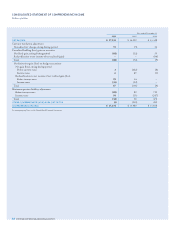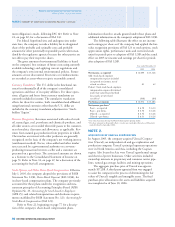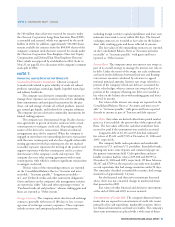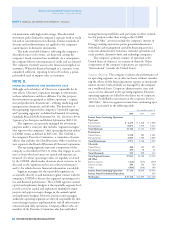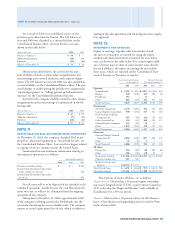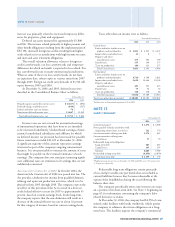Chevron 2006 Annual Report Download - page 63
Download and view the complete annual report
Please find page 63 of the 2006 Chevron annual report below. You can navigate through the pages in the report by either clicking on the pages listed below, or by using the keyword search tool below to find specific information within the annual report.
CHEVRON CORPORATION 2006 ANNUAL REPORT 61CHEVRON CORPORATION 2006 ANNUAL REPORT 61
including foreign currency capital expenditures and lease com-
mitments, forecasted to occur within 180 days. The forward
exchange contracts are recorded at fair value on the balance
sheet with resulting gains and losses refl ected in income.
The fair values of the outstanding contracts are reported
on the Consolidated Balance Sheet as “Accounts and notes
receivable” or “Accounts payable,” with gains and losses
reported as “Other income.”
Interest Rates The company enters into interest rate swaps as
part of its overall strategy to manage the interest rate risk on
its debt. Under the terms of the swaps, net cash settlements
are based on the difference between fi xed-rate and fl oating-
rate interest amounts calculated by reference to agreed
notional principal amounts. Interest rate swaps related to a
portion of the company’s fi xed-rate debt are accounted for
as fair value hedges, whereas interest rate swaps related to a
portion of the company’s fl oating-rate debt are recorded at
fair value on the balance sheet with resulting gains and losses
refl ected in income.
Fair values of the interest rate swaps are reported on the
Consolidated Balance Sheet as “Accounts and notes receiv-
able” or “Accounts payable,” with gains and losses reported
directly in income as part of “Interest and debt expense.”
Fair Value Fair values are derived either from quoted market
prices or, if not available, the present value of the expected cash
fl ows. The fair values refl ect the cash that would have been
received or paid if the instruments were settled at year-end.
Long-term debt of $5,131 and $7,424 had estimated
fair values of $5,621 and $7,945 at December 31, 2006 and
2005, respectively.
The company holds cash equivalents and marketable
securities in U.S. and non-U.S. portfolios. Eurodollar bonds,
fl oating-rate notes, time deposits and commercial paper are
the primary instruments held. Cash equivalents and mar-
ketable securities had fair values of $9,200 and $8,995 at
Decem ber 31, 2006 and 2005, respectively. Of these balances,
$8,247 and $7,894 at the respective year-ends were classifi ed
as cash equiv alents that had average maturities under 90 days.
The remainder, classifi ed as marketable securities, had average
maturities of approximately 1.4 years.
For the fi nancial and derivative instruments discussed
above, there was not a material change in market risk from
that presented in 2005.
Fair values of other fi nancial and derivative instruments
at the end of 2006 and 2005 were not material.
Concentrations of Credit Risk The company’s fi nancial instru-
ments that are exposed to concentrations of credit risk consist
primarily of its cash equivalents, marketable securities, deriva-
tive fi nancial instruments and trade receivables. The company’s
short-term investments are placed with a wide array of fi nan-
the 160 million shares that were reserved for issuance under
the Chevron Corporation Long-Term Incentive Plan (LTIP),
as amended and restated, which was approved by the stock-
holders in 2004. In addition, approximately 503,000 shares
remain available for issuance from the 800,000 shares of the
company’s common stock that were reserved for awards under
the Chevron Corporation Non-Employee Directors’ Equity
Compensation and Deferral Plan (Non-Employee Directors’
Plan), which was approved by stockholders in 2003. Refer to
Note 25, on page 82, for a discussion of the company’s common
stock split in 2004.
NOTE 7.
FINANCIAL AND DERIVATIVE INSTRUMENTS
Commodity Derivative Instruments Chevron is exposed
to market risks related to price volatility of crude oil, refi ned
products, natural gas, natural gas liquids, liquefi ed natural gas
and refi nery feedstocks.
The company uses derivative commodity instruments to
manage these exposures on a portion of its activity, including:
fi rm commitments and anticipated transactions for the pur-
chase, sale and storage of crude oil, refi ned products, natural
gas, natural gas liquids, and feedstock for company refi neries.
The company also uses derivative commodity instruments for
limited trading purposes.
The company uses Inter national Swaps Dealers Associa-
tion agreements to govern derivative contracts with certain
counterparties to mitigate credit risk. Depending on the
nature of the derivative transactions, bilateral collateral
arrangements may also be required. When the company is
engaged in more than one outstanding derivative transaction
with the same counterparty and also has a legally enforceable
netting agreement with that counterparty, the net marked-
to-market exposure represents the netting of the positive and
negative exposures with that counterparty and is a reason-
able measure of the company’s credit risk exposure. The
company also uses other netting agreements with certain
counterparties with which it conducts signifi cant transactions
to mitigate credit risk.
The fair values of the outstanding contracts are reported
on the Consolidated Balance Sheet as “Accounts and notes
receivable,” “Accounts payable,” “Long-term receivables –
net” and “Deferred credits and other noncurrent obligations.”
Gains and losses on the company’s risk management activities
are reported as either “Sales and other operating revenues” or
“Purchased crude oil and products,” whereas trading gains and
losses are reported as “Other income.”
Foreign Currency The company enters into forward exchange
contracts, generally with terms of 180 days or less, to man-
age some of its foreign currency exposures. These exposures
include revenue and anticipated purchase transactions,
NOTE 6. STOCKHOLDERS’ EQUITY – Continued



